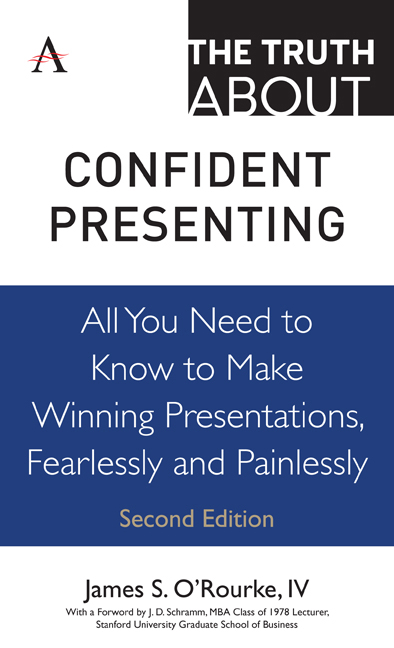 The Truth about Confident Presenting
The Truth about Confident Presenting Book contents
- Frontmatter
- Contents
- Foreword
- Introduction
- Part I Some Initial Truths
- Part II The Truth About Getting Ready to Speak
- Part III The Truth About What Makes People Listen
- Part IV The Truth About Developing Support for Your Presentation
- Part V The Truth About Getting Up to Speak
- Truth 25 Select a delivery approach
- Truth 26 Your introduction forms their first impression
- Truth 27 Begin with a purpose in mind
- Truth 28 Keep your audience interested
- Truth 29 Conclusions are as important as introductions
- Truth 30 Have confidence in your preparation
- Truth 31 Repeat the process as often as possible
- Part VI The Truth About Managing Anxiety
- Part VII The Truth About Nonverbal Communication
- Part VIII The Truth About Visual Aids
- Part IX The Truth About Handling an Audience
- Part X The Truth About What Makes a Presentation Work
- References
- Acknowledgments
- About the Author
Truth 29 - Conclusions are as important as introductions
from Part V - The Truth About Getting Up to Speak
- Frontmatter
- Contents
- Foreword
- Introduction
- Part I Some Initial Truths
- Part II The Truth About Getting Ready to Speak
- Part III The Truth About What Makes People Listen
- Part IV The Truth About Developing Support for Your Presentation
- Part V The Truth About Getting Up to Speak
- Truth 25 Select a delivery approach
- Truth 26 Your introduction forms their first impression
- Truth 27 Begin with a purpose in mind
- Truth 28 Keep your audience interested
- Truth 29 Conclusions are as important as introductions
- Truth 30 Have confidence in your preparation
- Truth 31 Repeat the process as often as possible
- Part VI The Truth About Managing Anxiety
- Part VII The Truth About Nonverbal Communication
- Part VIII The Truth About Visual Aids
- Part IX The Truth About Handling an Audience
- Part X The Truth About What Makes a Presentation Work
- References
- Acknowledgments
- About the Author
Summary
Conclusions are one of the most important (and most welcome) portions of any presentation. Why are they important? Well, for one thing, they offer one more opportunity to put your best evidence or most important ideas before your audience. They represent one last chance to say what you really mean, to reinforce your purpose for speaking and to ask for their support or compliance. Conclusions also provide the audience with a sense of logical and emotional closure.
Like introductions, conclusions serve a number of purposes:
Your conclusion signals the audience that the presentation is about to end. A presentation is a journey of sorts for your audience, and you are their guide. It's important that you signal or cue them when you've come to the final portion of the talk. You might want to use a word or phrase that alerts them that you're about to finish: “finally,” “in conclusion,” “let me sum up by saying …,” “as we bring this to a close,” or “let me close by saying … .”
That's also the appropriate moment to adjust your pacing, tone, pitch and rhythm to indicate that this presentation is just about done. Don't fall prey to the temptation to keep speaking, though. Nothing is more annoying at that point to the audience than a speaker who says, “in conclusion,” and then takes another 20 minutes to finish. An audience is forgiving of many things, but not of a speaker who overstays his welcome.
Your conclusion will help to summarize your main points. As a U.S. Air Force officer, I had the opportunity to deliver a number of mission-related briefings to various people. Those presentations were intended to be cogent, informative, to the point and useful to the audience. The advice from my commanders was always the same: “Tell them what you're going to tell ‘em. Tell ‘em. Then tell ‘em what you just told ‘em.” Preview, main body and conclusion in three short sentences. It's not bad advice, actually. Especially the part about “telling them what you told them.” A solid summary provides your audience with a review of your main points (in order), their motivations for learning about 29 and acting on them, and a final appeal which exhorts them to action.
- Type
- Chapter
- Information
- The Truth about Confident PresentingAll You Need To Know To Make Winning Presentations, Fearlessly And Painlessly, pp. 115 - 118Publisher: Anthem PressPrint publication year: 2019


